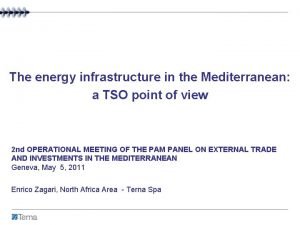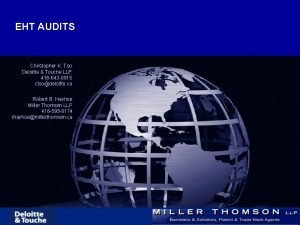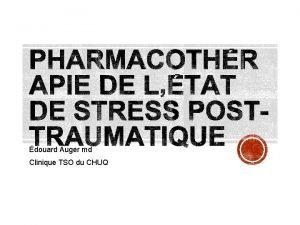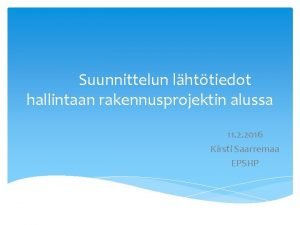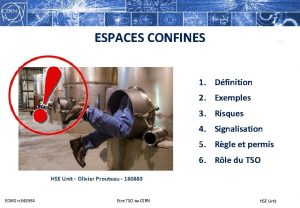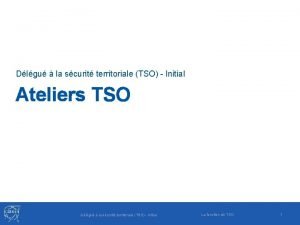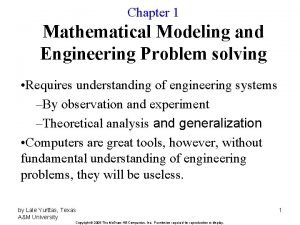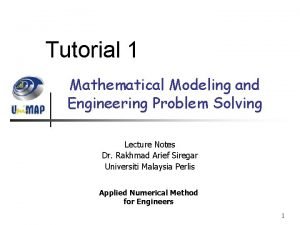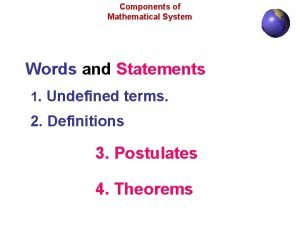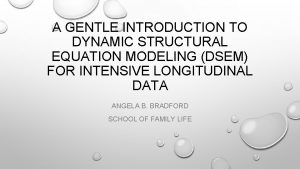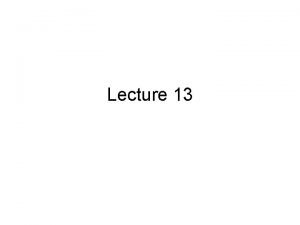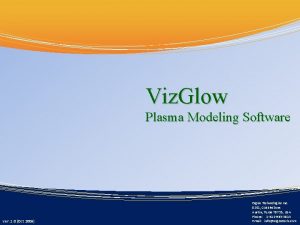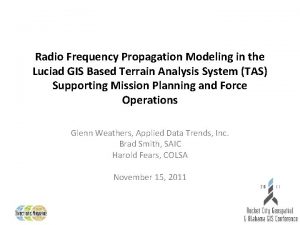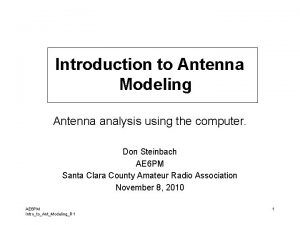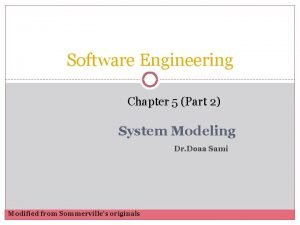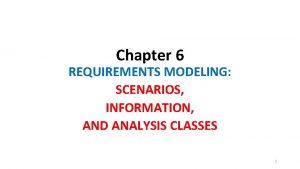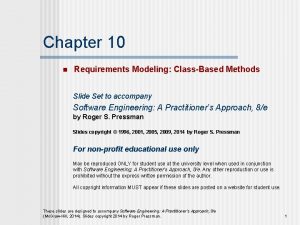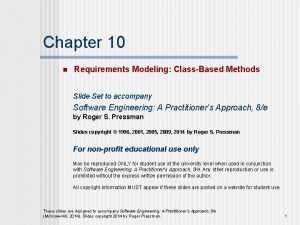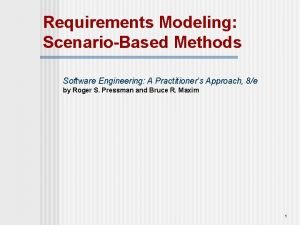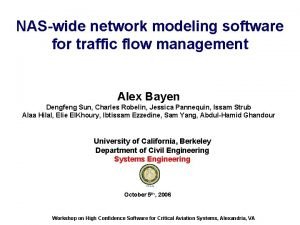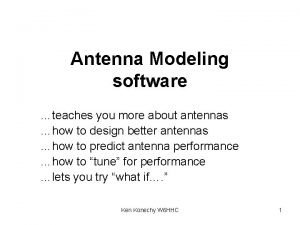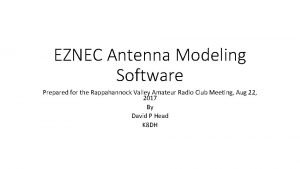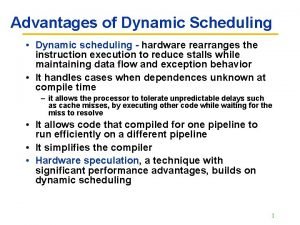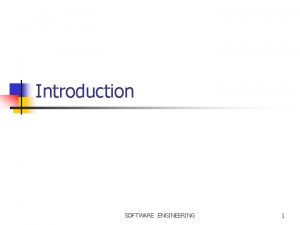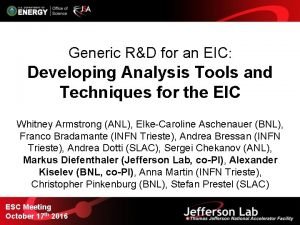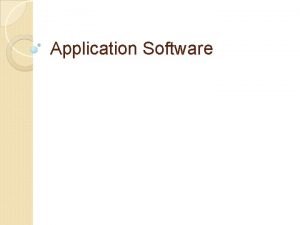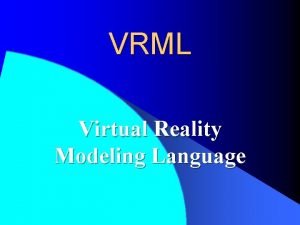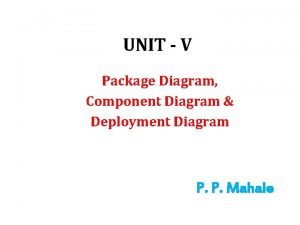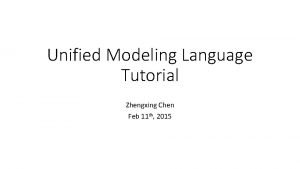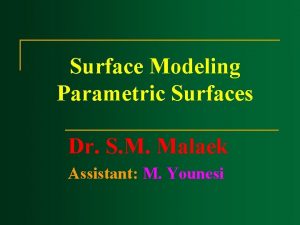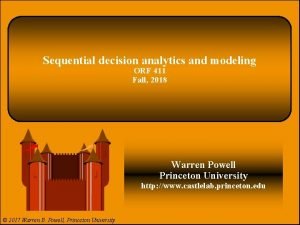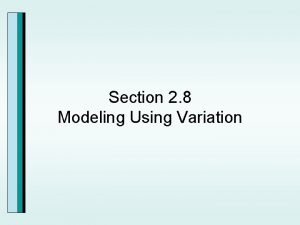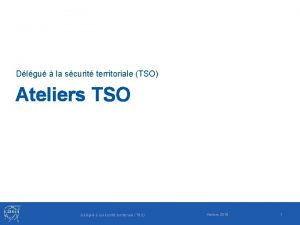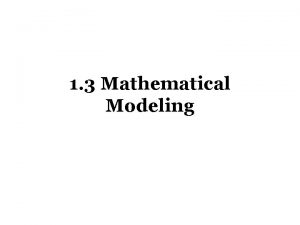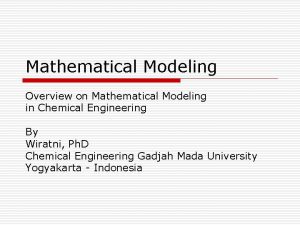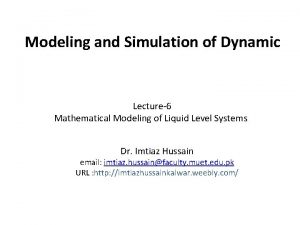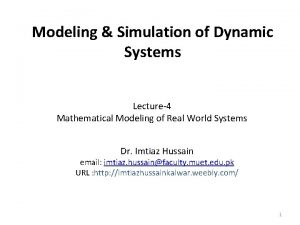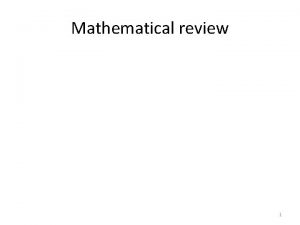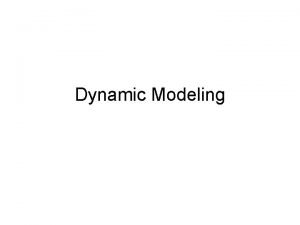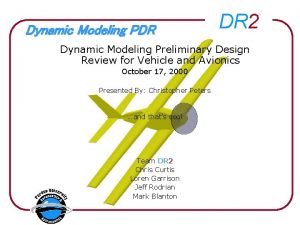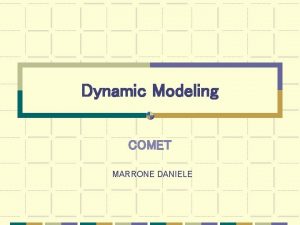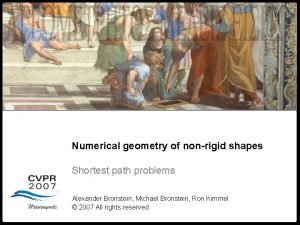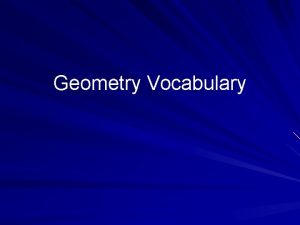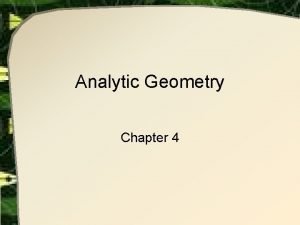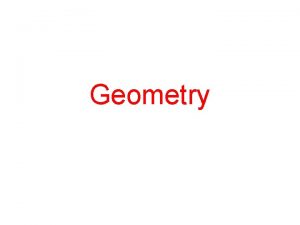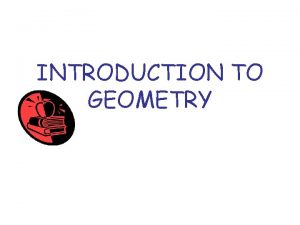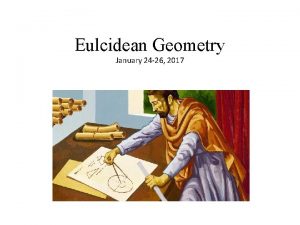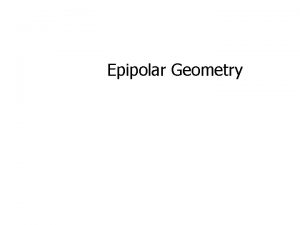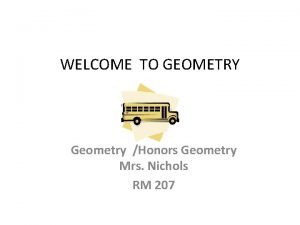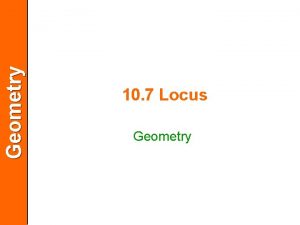Mathematical Modeling with Dynamic Geometry Software TaiYih Tso


























































- Slides: 58

Mathematical Modeling with Dynamic Geometry Software Tai-Yih Tso Department of Mathematics National Taiwan Normal University

Research Interests • My major research field is mathematics education, especially in how to integrate technology into mathematics learning and teachers education. • Earlier works: • Dynamics windows for ellipse instruction. • Cognitive characteristic of senior high school students in constructing multiple representations of ellipse. • The design of junior high school geometry based on van Hiele model. • The study of interrelationship between spatial abilities and van Hiele levels of thinking in geometry of eigth-grade students. • The study of junior high school students’ symmetry concept image. • The critical phase curve of Van der pol equation. • The derivation of two parallel zero-finding algorithm of polynomials.

Current research topics of mine • One of my current research topics is studying mathematical modeling in mathematics education. • I am interested in investigating theory and practice of teaching and learning mathematical modeling, particularly by using dynamic geometry software in the process of mathematical modeling.

Contents I. III. IV. V. Introduction Theoretical Framework A framework of mathematical modeling Case studies Concluding remarks

Introduction • In this presentation, I will talk about my experience of integrating computer into a class for potential teachers. The goal of this course is to provide an opportunity for potential teachers to explore geometry by using the dynamic geometry software, such as Carbri, The Geometers’ Sketchpad. Moreover, they are expected to use this technical tool and their geometry knowledge to teach geometry in middle schools in the future. Usually, I use mathematics modeling as my teaching strategy in class.

Why students need to learn mathematical modeling • Why students ought to learn mathematical modeling is that it provides a means for understanding the world around us, for coping with everyday problems, for developing mathematical knowledge, and for preparing for future professions. • Today mathematical model and modeling have invaded a great variety of disciplines. • Mathematical modeling has been substantially supported and accelerated by the availability of powerful electronic tools, such as computers with their enormous communication capabilities. (Werner Blum ET AL. 2002)

Structural Aspect of Mathematical Modeling • A model is a structure R(S, P, M, T). In this relation structure, M is a model made by a subject S from a real world prototype T for the particular purpose of P (Leo Apostel, 1960). • Thus the outcome model M of a certain T varies by two factors which are the subject S and purpose P. In other words, the same prototype T would lead to different models M due to different purposes and subjects.

Structural Aspect of Mathematical Modeling • A model as subjects taking the object as model of the object during the time and in view of the aim (H. Stachowiak, 1973). • He mentioned that in addition to subject and purpose, there is still another factor affecting the outcome model, which is time. • He pointed out three important properties of a model: the mapping property, the shortening property, and the pragmatic property.

Conceptual Aspect of Mathematical Modeling • Models are conceptual systems (consisting of elements, relations, operations, and rules governing interactions) that are expressed using external notation system, and that are used to construct, describe, or explain the behaviors of other systems – perhaps so that the other system can be manipulated or predicted intelligently. • A mathematical model focuses on structural characteristics (rather than, for example, physical or musical characteristics) of the relevant system. (Richard Lesh & Helen M. Doerr, 2000)

Mathematical Modeling • Mathematical models are mathematical structure describing a real world phenomenon that would differ according to different subjects, purpose and time being. • Mathematical modeling is a process that attempts to match observation with symbolic statement by creating a mathematical representation of some phenomenon in the real world in order to gain a better understanding of that phenomenon.

Theoretical Framework • 訊息處理認知模式



Theoretical framework

environments supporting

Reflection-on-action q. A action of metacognition involves stepping back and representing a difficulty, searching for solution, and conjecturing action in the construction or reconstruction knowledge (Noddings, 1984). q. Reflection includes a state of doubt and an act of resolution. (Deway, 1933) q. The complex schema of knowledge is active in the long-term memory during performance of reflection-on-action q. Reflective abstraction is a process in which individual try to construct abstract structures in long-term memory, operations by reflecting on their activities, and the arguments used in social interaction. (piaget, 1976)

A framework of mathematical modeling: Mathematical modeling as learning activities for reflection-onaction q. Mathematical modeling is a process of using mathematical language to describe, communicate, express, and think about the real world q Learning mathematics is like learning language. It is not only to learn vocabulary (symbol, definition), grammar(property, rule, procedure) but more important to use it (mathematical modeling). q. Mathematical modeling has usually been applied in the research field, students have seldom experience in the process of building a mathematical model. q. A major benefit in learning how to do mathematical modeling for students is to encourage them developing a particular way of reflecting and acting on mathematics through making connections between mathematics and real world. q. Mathematical modeling is incorporated into the learning activities for two reasons: for examplification and application (Nesher, 1989).

Mathematical Modeling in multiple representation window

An example for learning mathematical modeling A Real World Problem: There are three fire stations and a fire center(119) in a city. A fire is reported to the fire center at a certain address, which of the three fire stations should send firefighters to the scene? How do we know which is closest?

Two Approaches for the Fire Problem Suppose we had a city map on which the sites of the fire stations are indicated with dots. 1. We could use a ruler measuring the distance from the fire to each station on the map. 2. We could divide the map to three regions, each region containing one fire station and consisting of all the points closer to that station than to any other.

Mathematical model 1. (Voronoi Diagrams) A, B, C are three distinct points on a plane. How do we divide the plane into three regions, each region containing a point and consisting of all the points closer to that point than to any other points? 2. (Inverse problem)

A case study on modeling a heart-shaped figure at the bottom of a cup • Due to the fact that applying computer to mathematical modeling is important for students and they seldom have the chance to experience it. • It is necessary to provide them with a computational environment. In order to design this environment, we need to understand the mathematical modeling process of students, and thus a case study is done on potential teachers, for teachers need to have the experience before they can teach students. • The major concerns of this case study are the process of potential teachers doing mathematical modeling, and the role of the dynamic geometric software in the process.

Experimental Design • The subjects of this experiment are 24 potential teachers divided into five groups. • The study of this paper would be focusing on the mathematical modeling process of one group came up with a more complete result. • Only a more complete mathematical modeling process, it can help the researcher draw out the features of this process.

Experimental Design • The setting of this experiment was in the computer room where each student had his own computer to work on. The students gathered into groups and were encouraged to discuss and solve the task. The classroom was videotaped and the discussion of each group was recorded separately.

A case study on modeling a heart-shaped figure at the bottom of a cup • As an example, I shall illustrate students’ modeling process with the Geometer’s Sketchpad (GSP). • It starts generally from specifying the real world phenomena or problems in the process of mathematical modeling.

Specifying real-world phenomena • For the experiment that day I brought a cylindrical mug and a flash light to class and let students look at the bottom of mug with the flash light as a point source of light overhead. • By experimenting and observing this phenomenon, they wanted to understand two modeling problems: (1)Why did the bottom of the cup display a heart shape? (2)What is the equation of the curve of the heart shape in mathematics?

Making Assumptions and Simplifications • • • The students analyzed the bright pattern within group discussion and found that the bottom of the mug is illuminated by rays directly from the flash light and by rays reflected one or more times. They proposed a hypothesis that the hart-shaped pattern is mainly contributed by the reflections of rays at the bottom. They simplified the cylindrical mug, a three dimension model, to the circular rim, a plane model.

Examining assumptions with GSP • After making the assumption, a student said that we could use GSP to examine how the reflections of rays work. • They found that the computer graph is similar to the heart-shaped figure at the bottom of the mug and could explain the real world phenomena.

Exploring the Mathematical Model • Students used computer simulation to develop a useful representation system for mathematical model (creating a coordinate system and choosing suitable parameters to describe the curve).

Modifying the Mathematical Model • Students constructed a conceptual system, which is expressed by mathematical symbols, formulas, and rules in order to interpret the behaviors of the real world.

Experiment Observations and Findings • From the above observations, I would like to conclude them into the following three findings. • Potential teachers explore in between three worlds, which are the real world, the mathematical world, and the computer world. • The transition between the three worlds is based on reflective acting. • The dynamic geometric software not only simulates the mathematical model, but also connects two aspects of mathematics, which are the experimental mathematics and the reasoning mathematics.

Experiment Findings Real world 1. Observing physical phenomenon and forming modeling task 2. Making assumptions and simplification to form real-world model. 11. Examining the mathematical model. Reflecting and Acting Mathematical world 6. Creating coordinate system and setting representation. 7. Choosing parameters and studying the relations among them. 8. Forming the equation (mathematical model) 10. Modifying the mathematical model. 13. investigating the mathematics history abort the mathematical model. Computer world 3. Simulating the real-world model and forming the computing model. 4. Examining the assumptions and simplification 5. Developing conceptual tool to think mathematically. 9. Simulating the mathematical model. 12. Simulating the modified mathematical model.

Concluding remarks Real World making meaningful situations into mathematical descriptions Mathematical World Using symbolically described situation to interpret the real world Experiment Geometry Bridge observing, manipulating GSP Simulation Computing World Reasoning Geometry conjecturing, justifying

BELIEVES Other Knowledge Fundamental assumptions METACOGNITION Monitoring, evaluation, planning and controlling. PROBLEM DOMAIN Domain-specific reasoning MATHEMATICAL DOMAIN COMPUTATION DOMAIN Domain-specific reasoning Simulation reasoning From the cognitive psychology point of view, we can use this figure to explain.

Research issues of mathematical modeling with DGS in mathematics education • What authentic modeling materials are available? • How does the authentic materials affect students’ mathematical learning and modeling? • What are the process components of modeling? • What is the meaning and role of abstraction, proof, proving, formalization, and generalization in the process of modeling? • What are the additional roles and functions of computer in the process of modeling? • What training strategies can be used to assess a future teacher’s ability to teach mathematical modeling? Real World Mathematical World Computing World


Two Questions about GSP • What is the difference between the circle drawing tool in GSP and the mechanical compass? • Do we have any tools for drawing a straight line? In other words, how can I guarantee that the line segment I get from a ruler is a definite straight line?

Human intellectual activities • According to Vygostkian socio-cultural perspective, the formation of human intellectual activities requires the use of technical and symbolic tools as mediators of acting and thinking. • In order for the students to solve problems systematically, I believe to introduce the culture and history of human development in mathematics is helpful for increasing their interest in both geometry and history in mathematics.

What is the difference between the circle drawing tool in GSP and the mechanical compass? Study history of mathematics before Build up a mathematical model • • The students studied Euclid’s Elements in order to investigate the Euclidean construction tools. They noted that the first three postulates of Euclid’s Elements is to state the primitive construction tools. Let the following be postulated: to draw a straight line from any point to any point. to produce a finite straight line continuously in a straight line. to describe a circle with any center and distance. The first two postulates state what we can do with a ruler(Euclidean straightedge) and the third postulate tell us the circle drawing instrument(Euclidean compass). The Euclidean straightedge is a tool to draw the straight line of passing through given two distinct points and the Euclidean compass is a tool to draw a circle of given a center and passing through a given point. Both of these two primitive construction tools can not be marked.

The Euclidean compass and the modern mechanical compass • The students noted that the construction tools of the Geometer’s Sketchpad are just the Euclidean construction tools after studying the postulates of Elements. • They also found that the Euclidean compass differs from the modern mechanical compass which can draw a circle of given center and radius. • The Euclidean compass (computer compass) is often referred as a collapsing compass that if either leg is lifted from the paper the tool immediately collapses. • The students asked naturally a problem if the Euclidean compass can serve as the modern mechanical compass.

Build up a mathematical model • This is not easy for our students to obtain the idea of the construction procedure(mathematical model ). • They continuously read the Elements and found that the proposition 2 of Book I. • “To place at a given point a straight line equal to a given straight line” is useful for the model. • The construction of the proposition 2 shows that the Euclidean compass + the Euclidean straightedge is equivalent to the modern compass.

students’ report : • In our original knowledge, we believed that the history of mathematics and the drawing tool of mathematical software unrelated. • Now we find that the history of mathematics can give us hints to overcome the restriction of computer technology. • We understand much more about the Euclid’s Elements.

Do we have any tools for drawing a straight line? • The second question is particularly practical. • James Watt (1736 -1819) had a problem when he worked on improving the efficiency and power of steam engines. • His problem was how to turn the linear motion into the circular motion of a wheel and vice versa.

Study history of mathematics before making computer simulation • • The students read the book “A Survey of Geometry” by Howard Eves, and the paper “How to Draw a Straight Line” by Daina Taimina. They noted that An outstanding geometrical problem of the last half of the nineteen century was to discover a linkage mechanism for drawing a straight line.

• • A solution was finally found in 1864 by a French army officer, A. Peaucellier (1832 -1913), and an announcement of the invention was made by A. Mannheim (1831 -1906), a brother officer of engineers and inventor of the so-called Mannheim slide rule, at a meeting of the Paris Philomathic Society in 1867. But the announcement was little heeded until Lipkin, a young student of the celebrated Russian mathematician Chebyshev (1821 -1894), independently reinvented the mechanism in 1871. Lipkin received a substantial reward from the Russian Government. Peaucellier’s merit was finally recognized and he was awarded the great mechanical prize of the Institut de France.

students’ report : • Form the History, we noted that a pure geometrical problem can be connected with a mechanical problem. • We also learnt what is the Peaucellier. Lipkin Linkage.

Conclusion Remarks • 1. Through the history of mathematics they can understand where the mathematic questions came from and in which direction they will develop. • 2. It gives students a complete concept and a picture as a whole of geometry. • 3. While tracing the paths of mathematics history, they can get ideas for solving their problems. • 4. It provides an environment for students to experience reflective thinking.

Research issues of mathematical modeling with DGS in mathematics education • What authentic modeling materials are available? • How does the authentic materials affect students’ mathematical learning and modeling? • What are the process components of modeling? • What is the meaning and role of abstraction, proof, proving, formalization, and generalization in the process of modeling? • What are the additional roles and functions of computer in the process of modeling? • What training strategies can be used to assess a future teacher’s ability to teach mathematical modeling? Real World Mathematical World Computing World


The floor is open for suggestions and comments. Thank you for your participation.








Research issues of mathematical modeling with DGS in mathematics education • What authentic modeling materials are available? • How does the authentic materials affect students’ mathematical learning and modeling? • What are the process components of modeling? • What is the meaning and role of abstraction, proof, proving, formalization, and generalization in the process of modeling? • What are the additional roles and functions of computer in the process of modeling? • What training strategies can be used to assess a future teacher’s ability to teach mathematical modeling? Real World Mathematical World Computing World
 Modeling and role modeling theory
Modeling and role modeling theory Relational vs dimensional data modeling
Relational vs dimensional data modeling Tso energy corridor
Tso energy corridor Cern tso
Cern tso Tso deloitte
Tso deloitte Clinique tso
Clinique tso Sairaalasuunnittelu
Sairaalasuunnittelu Spanish tso
Spanish tso Tso cern
Tso cern Cern tso
Cern tso Mathematical modeling of mechanical systems
Mathematical modeling of mechanical systems Mathematical modeling and engineering problem solving
Mathematical modeling and engineering problem solving Mathematical modeling and engineering problem solving
Mathematical modeling and engineering problem solving Elements of mathematical economics
Elements of mathematical economics Undefined terms definition
Undefined terms definition Dynamic structural equation modeling
Dynamic structural equation modeling What are the steps of dynamic programming approach
What are the steps of dynamic programming approach Electron geometry and molecular geometry
Electron geometry and molecular geometry Electron domain geometry vs molecular geometry
Electron domain geometry vs molecular geometry Covalent bond order
Covalent bond order Transferered
Transferered Plasma simulation software
Plasma simulation software Point of sale use case diagram
Point of sale use case diagram Rf propagation modeling software
Rf propagation modeling software Antenna modeling for beginners
Antenna modeling for beginners Structural models in software engineering
Structural models in software engineering Scenario based modeling in software engineering
Scenario based modeling in software engineering Class based modeling in software engineering
Class based modeling in software engineering Class based modeling in software engineering
Class based modeling in software engineering Scenario-based modeling in software engineering
Scenario-based modeling in software engineering S o f t w a r e f o r t r a f f i c
S o f t w a r e f o r t r a f f i c Antenna modeling software
Antenna modeling software Eznec antenna
Eznec antenna Benefits of dynamic scheduling software
Benefits of dynamic scheduling software Dynamic control software
Dynamic control software Dynamic digital signage software
Dynamic digital signage software Software maintenance process models ppt
Software maintenance process models ppt Who invented software engineering
Who invented software engineering Improving software economics in project management
Improving software economics in project management Software engineering vs computer science
Software engineering vs computer science What is software metrics in software engineering
What is software metrics in software engineering Chapter 3 skills and applications
Chapter 3 skills and applications Generic software and custom software
Generic software and custom software Difference between student software and industrial software
Difference between student software and industrial software Software crisis in software engineering
Software crisis in software engineering Software metrics example
Software metrics example Is an os system software or application software
Is an os system software or application software Eic software software review
Eic software software review Real time software design in software engineering
Real time software design in software engineering Software design fundamentals in software engineering
Software design fundamentals in software engineering Computer graphics software allows the user to create
Computer graphics software allows the user to create Virtual reality modeling language
Virtual reality modeling language Common modeling techniques of deployment diagram
Common modeling techniques of deployment diagram Unified modeling language tutorial
Unified modeling language tutorial Threat modelling web application
Threat modelling web application Parametric surface modeling
Parametric surface modeling Simulation modeling and analysis law kelton
Simulation modeling and analysis law kelton Sequential decision analytics and modeling
Sequential decision analytics and modeling Modeling using variation
Modeling using variation


